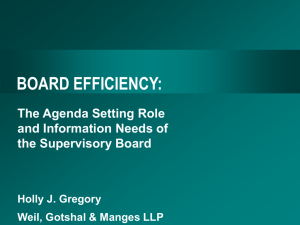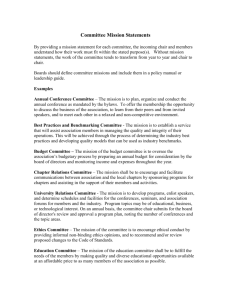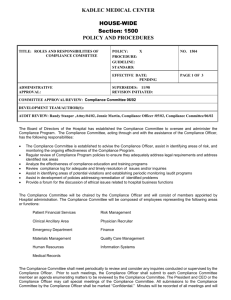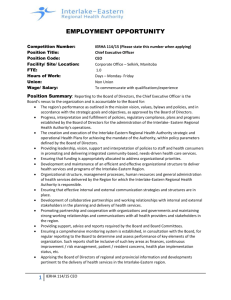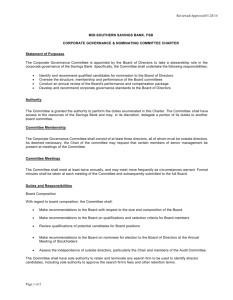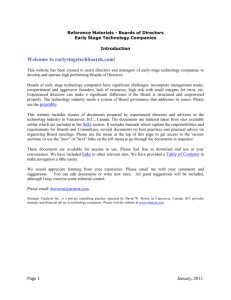Board of Directors Mandate
advertisement
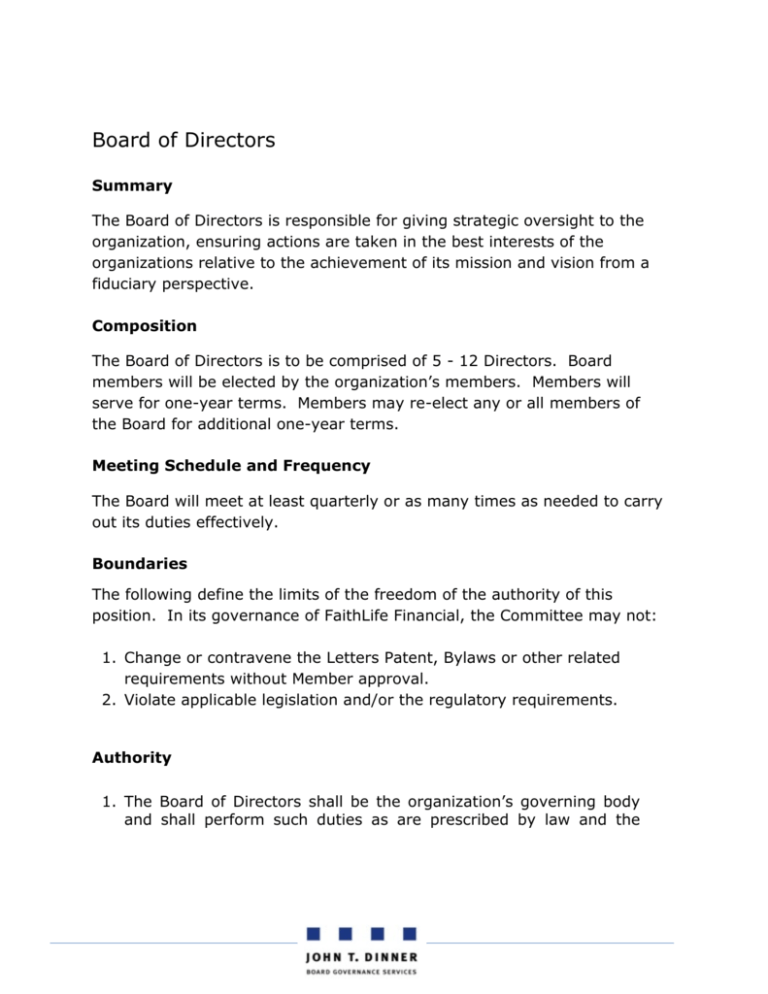
Board of Directors Summary The Board of Directors is responsible for giving strategic oversight to the organization, ensuring actions are taken in the best interests of the organizations relative to the achievement of its mission and vision from a fiduciary perspective. Composition The Board of Directors is to be comprised of 5 - 12 Directors. Board members will be elected by the organization’s members. Members will serve for one-year terms. Members may re-elect any or all members of the Board for additional one-year terms. Meeting Schedule and Frequency The Board will meet at least quarterly or as many times as needed to carry out its duties effectively. Boundaries The following define the limits of the freedom of the authority of this position. In its governance of FaithLife Financial, the Committee may not: 1. Change or contravene the Letters Patent, Bylaws or other related requirements without Member approval. 2. Violate applicable legislation and/or the regulatory requirements. Authority 1. The Board of Directors shall be the organization’s governing body and shall perform such duties as are prescribed by law and the organization’s Bylaws and described in the Directors’ Handbook and shall transact such other pertinent business as may come before it. The Board shall discharge its role as the organization’s governing body at meetings of the Board. 2. The Board acknowledges the regulatory authority of various departments of government. 3. The Board may seek outside advice or expertise and incur reasonable expenses on the organization’s behalf. 4. The Board may delegate its authority and responsibility to Board Committees and CEO. Delegation is in writing clearly spelling out scope and conditions. Boundaries The following define the limits of the freedom of the authority of the Governing Board of Directors. In its governance of FaithLife Financial, the Board may not: Change or contravene the organization’s Letters Patent or Bylaws. Violate applicable legislation and/or the regulatory requirements. Responsibilities and Expectations The Board’s responsibilities are to: Design the Board Structure and Processes 1. Review and recommend revisions to Bylaws to Members. 2. Approve and maintain governing policies and processes. 3. Approve the composition, organization and responsibilities of the Board and its Committees. 4. Elect the Board Chair and Board Vice-Chair. 5. Review the Board’s structure. 6. Appoint members of Board Committees. Govern the Missional and Strategic Planning 1. Establish the organization’s mission and any major changes in strategic direction, including an annual review of missional services, beneficiaries and places. 2. Adhere to the definitions of “Missional, Operational, Strategic and Tactical” as approved by the Board from time to time. 3. Approve a strategic planning process for the organization’s development and operation. 4. Approve an annual organizational forecast and goals (i.e. Staff’s forecast of income and key performance indicators). 5. Establish and carry out the Board’s responsibility of trusteeship by ensuring the continuity and long-term interest of the organization and those it serves. 6. Review the results achieved by Staff as compared with the mission, strategic and operational goals. 7. Ensure the organization has sufficient organizational, governance, leadership and management strength to achieve its mission and its short and long term goals. 8. Provide for the stability and growth needs of the organization and maintain its capacity to meet changing or unforeseen circumstances and conditions. Delegate Management Authority and Responsibility to the CEO 1. Select and appoint the CEO. 2. Approve appointment of senior staff upon recommendation of the CEO. 3. Approve the annual compensation and benefits for the CEO and senior staff. 4. Ensure a succession plan is in place for the CEO and Corporate Officers. 5. Approve the CEO position description. Monitor Compliance and Risk and Measure Results 1. Ensure adherence to the organizations Letters Patent and Bylaws. 2. Ensure the organization’s assets are safeguarded. 3. Exercise responsibility for ongoing fiduciary oversight. 4. Review the results achieved by Staff as compared with the organization’s mission, strategic and operational goals. 5. Review the performance of the CEO and approve related compensation. 6. Receive regular reports of the deliberations and activity of Board Committees. 7. Ensure that Staff has in place policies and procedures necessary to comply with regulatory requirements and related legislation affecting the operation of the organization. 8. Ensure that the Board and its members have complied with relevant laws affecting conduct and decision-making. 9. Recommend to Members the appointment of an independent auditor annually. 10. Provide for and encourage open dialogue between Directors and Management. 11. Monitor internal control framework. 12. Monitor review of retirees’ pension and benefits. Accountability The Board is accountable to the Members of the organization for fulfilling the expectations of the responsibility of governance. The election of Directors to the Board is the primary means of accountability. The Board shall provide timely and accurate reporting to the Members in an Annual Report and monitor Member engagement and satisfaction. The Board shall also exercise its accountability to the Members by reviewing at least every two years its own structure, processes and performance as set forth in a Directors’ Handbook: 1. Review the performance of the Board and its Committees, and, where deemed necessary, initiate actions to achieve improvement. 2. Ensure the Board and its Committees are adequately and currently informed of the condition and operations of the organization. 3. Communicate accurately and promptly to Members concerning the organization’s financial position. Board Leadership The role of the Committee Chair is to: Foster a constructive tone so that the Committee works as a cohesive team. Assist the Board Chair in developing and fostering a healthy Board culture. Ensure that the informational needs of Committee members are met. Promote the independent thinking and decision-making of the Committee. Build consensus among Committee members. Ensure meeting time is used effectively. Monitor Committee activities to ensure the work undertaken is consistent with the mandate and does not interfere with Management’s responsibilities. Work with the Board Chair to ensure that the Committee fulfills its mandate and completes its work plan efficiently and effectively. Move Committee discussion towards a constructive and timely resolution. Other The Board will: Retain external advisors to provide relevant expertise and any other support as required or deemed appropriate. Ensure Directors are provided with the appropriate resources and education to fulfill the Board’s responsibilities.
